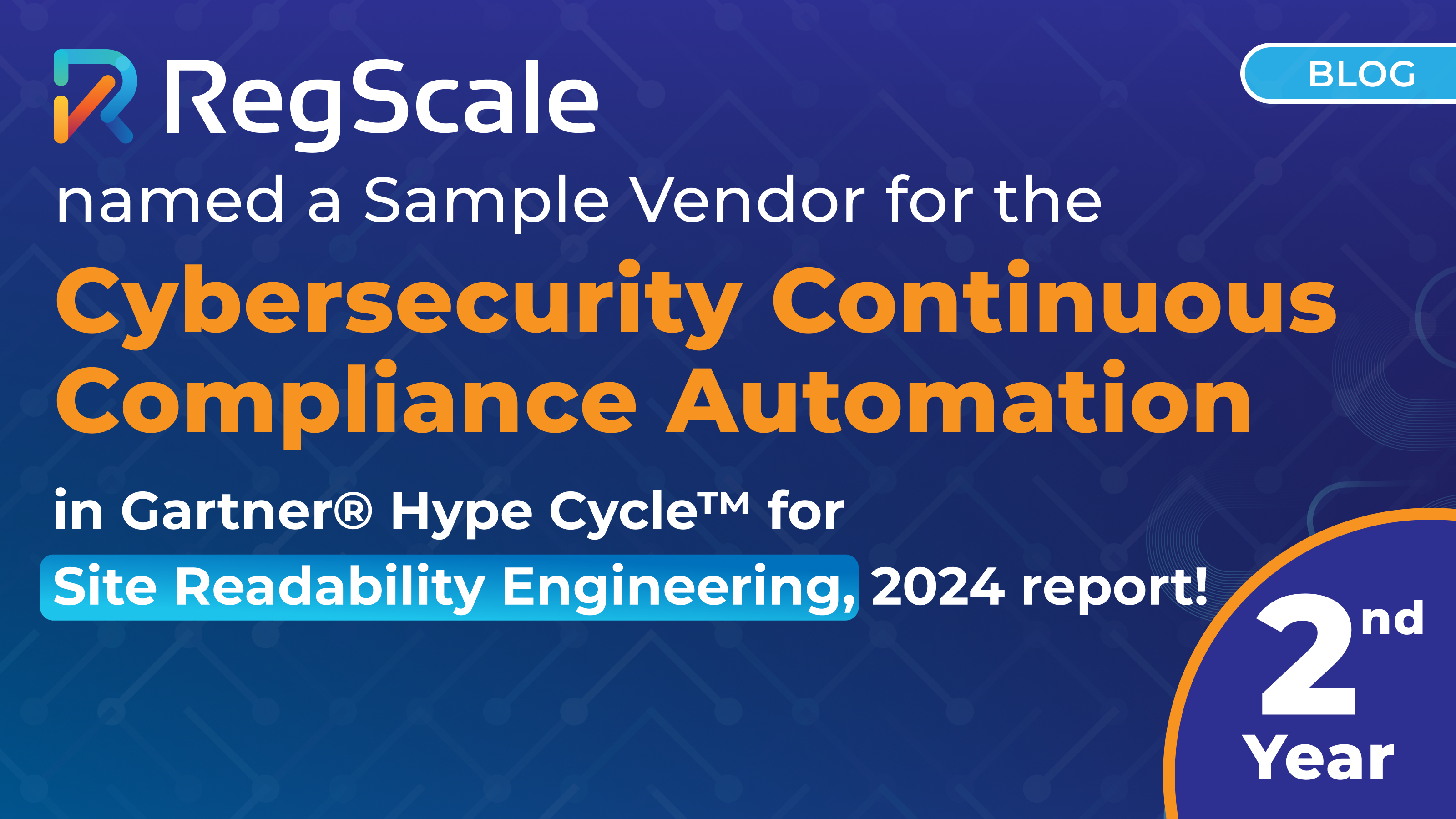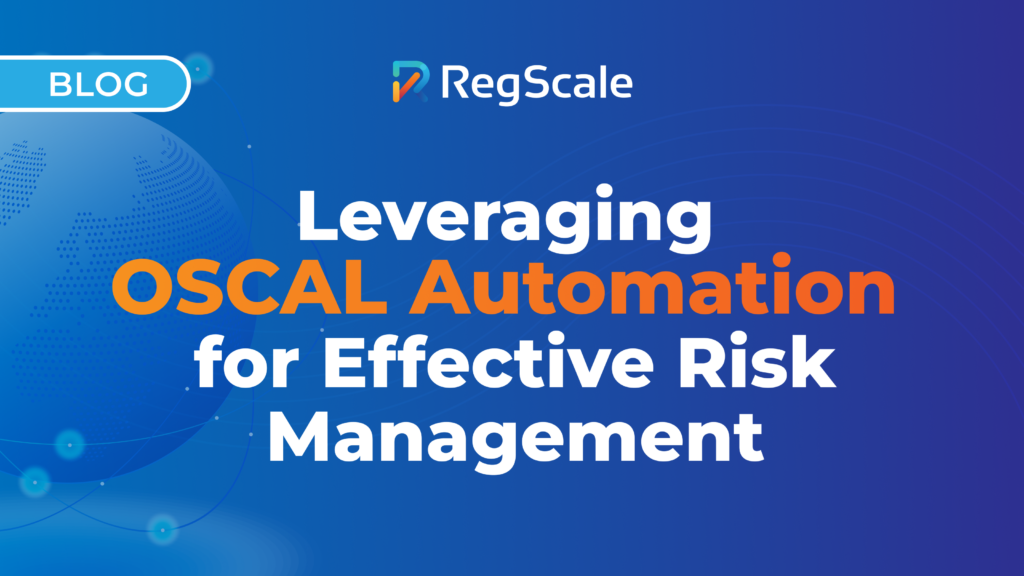RegScale Recognized as a Sample Vendor for
DevOps Continuous Compliance Automation category in the Gartner® Hype Cycle™ for Site Reliability Engineering, 2024 report

For the second year in a row, RegScale is recognized as a SampleVendor for DevOps Continuous Compliance Automation category in the Gartner’s Hype Cycle report for Site Reliability Engineering, 2024, written by Hassan Ennaciri, Daniel Betts, and Chris Saunderson.
“Gartner Hype Cycle methodology gives you a view of how a technology or application will evolve over time, providing a sound source of insight to manage its deployment within the context of your specific business goals.”* Of particular interest is that Gartner identifies DevOps Continuous Compliance Automation (CCA) in the “Adolescent” maturity stage, implying that the technology has moved past its Innovation Trigger phase and is predicted to gain wide acceptance in the next 2-5 years.
According to Gartner, “SRE practices enable organizations to focus on customer experience by improving software delivery velocity while optimizing reliability, performance, cost and value. I&O leaders should leverage this Hype Cycle to invest in new practices and tools, and upskill their teams to improve SRE maturity.”
The Gartner report states, “By 2027, 75% of enterprises will use site reliability engineering practices across their organizations to optimize product design, cost, and operations, up from 30% in 2024.” As noted by Gartner, “One of the most critical responsibilities of SREs is to balance the need for frequent changes with system stability and reliability. To optimize the delivery of software development (more about streamlining compliance through the software development life cycle in this resource), SREs need to balance the need for recurring changes with system stability and reliability. “Optimizing delivery enables quicker deployments of new features and bug fixes, which leads to faster innovation cycles and faster delivery of value to customers. This, in turn, leads to increased business agility.” Gartner identifies DevOps continuous compliance automation as an essential practice to focus on in optimizing delivery.
Understanding DevOps Continuous Compliance Automation (CCA)
In a world of agile, DevOps, DevSecOps, and platform engineering, demonstrating compliance requirements swiftly and effectively can be a significant challenge. DevOps Continuous Compliance Automation tools are designed to address this need. These tools consistently enforce guardrails, identify and assess policy gaps, and audit security and compliance across product and platform delivery lifecycles.
Why DevOps CCA Matters?
Organizations face increasing regulatory pressure, and this trend shows no sign of slowing down. Compliance requirements are expanding beyond traditional areas to include cybersecurity and government mandates. As these requirements grow, DevOps teams are required to integrate continuous compliance automation into their workflows.
Continuous compliance automation tools enable organizations to achieve and report on compliance as an integral part of their delivery pipelines and not an afterthought. These tools automate the assessment of security and compliance policies within secure, change-managed toolchains, facilitating the efficient generation of audit reports and their dissemination to audit consumers.
Critical Drivers for Adopting CCA
Automating compliance becomes crucial for maintaining workflow efficiency with the mounting regulatory pressure. New compliance requirements are continuously introduced, necessitating rapid support and adaptation. Compliance activities are increasingly handled through automated testing, enhancing developer efficiency and reducing the risk of audit failures. DevOps initiatives often involve various toolchains that all require compliance insights and controls. Integrating compliance into the toolchain becomes more feasible as cloud-native application architectures and development models become more prevalent. Traditional compliance reporting, benchmarking, and assessments are often manual and slow, highlighting the need for automation.
Common Obstacles for DevSecOps Teams
Failing to engage compliance and security subject matter experts early in the development lifecycle can lead to poor policy understanding and implementation. Effective auditing with DevSecOps and Continuous Compliance Automation tools requires a formal, change-controlled, secure toolchain. Inconsistent understanding and implementation of rule sets can hinder the effectiveness of Continuous Compliance Automation. Assuming that Continuous Compliance Automation alone ensures compliance without additional efforts can increase the risk of compliance failures.
User Recommendations by Gartner for Implementing DevOps Continuous Compliance Automation
- “Collaborate on design, implementation and ongoing strategy with key stakeholders, including internal audit, compliance and security.
- Adhere to compliance, governance and security requirements while creating a leaner operating environment.
- Implement a “shift-left” approach to ensure compliance controls and evidentiary data are understood and applied earlier in the development process.
- Implement automated compliance checks at every phase of the pipeline, demonstrating a “shift-secure” approach.
- Provide a continuous approach to prevent, detect and correct audit failures, and remove manual reporting activities.
- Enable efficient compliance policy checking to measure benchmarks, perform assessments and report on compliance policy controls.”
With RegScale’s continuous controls monitoring platform, I&O and SREs shift left security by leveraging compliance as code/OSCAL (Open Security Controls Assessment Language) and automating every control lifecycle phase. The platform delivers always-on readiness and self-updating paperwork that integrates compliance as code into the CI/CD pipelines, speeds certification, reduces costs, and future-proofs security posture. The OSCAL-native platform integrates compliance as code into DevSecOps processes to demonstrate compliance requirements across the product development and delivery life cycle stages.
Only Gartner members can access the full report (For Gartner subscribers only):
Gartner, Hype Cycle for Site Reliability Engineering, 2024, Hassan Ennaciri, Daniel Betts 20 June, 2024
*Gartner Methodologies, Gartner Hype Cycle
GARTNER is a registered trademark and service mark of Gartner, Inc. and/or its affiliates in the U.S. and internationally and is used herein with permission. All rights reserved. Gartner is a registered trademarks of Gartner, Inc. and/or its affiliates in the U.S. and internationally, and HYPE CYCLE is a registered trademark of Gartner, Inc. and/or its affiliates and are used herein with permission. All rights reserved. Gartner does not endorse any vendor, product or service depicted in its research publications, and does not advise technology users to select only those vendors with the highest ratings or other designation. Gartner research publications consist of the opinions of Gartner’s research organization and should not be construed as statements of fact. Gartner disclaims all warranties, expressed or implied, with respect to this research, including any warranties of merchantability or fitness for a particular purpose.
Ready to get started?
Choose the path that is right for you!
Skip the line
My organization doesn’t have GRC tools yet and I am ready to start automating my compliance with continuous monitoring pipelines now.
Supercharge
My organization already has legacy compliance software, but I want to automate many of the manual processes that feed it.
